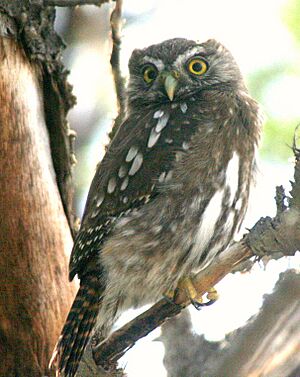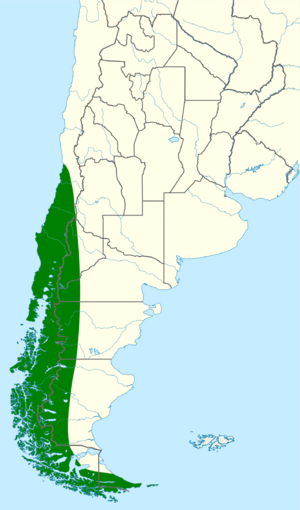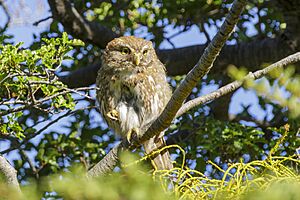Austral pygmy owl facts for kids
Quick facts for kids Austral pygmy owl |
|
|---|---|
 |
|
| Conservation status | |
| Scientific classification | |
| Genus: |
Glaucidium
|
| Species: |
nana
|
 |
|
| Distribution of austral pygmy owl Resident | |
The austral pygmy owl (Glaucidium nana) is a small, fascinating owl that lives in parts of South America. It belongs to the owl family called Strigidae. You can find this owl in the countries of Argentina and Chile.
Contents
About the Austral Pygmy Owl
Scientists have studied the austral pygmy owl's DNA and other features. They found that it is its own unique species, not just a type of another owl called the ferruginous pygmy owl. This means it's special!
What Does It Look Like?
The austral pygmy owl is about 17 to 21 centimeters (6.7 to 8.3 inches) long. That's roughly the size of a small soda can! Male owls weigh between 56 and 75 grams (2 to 2.6 ounces), while females are a bit heavier, weighing 70 to 100 grams (2.5 to 3.5 ounces).
These owls can have different colors. Some are grayish-brown, and others are reddish-brown. They also have mixes of these colors. Both male and female owls have:
- A pale grayish-brown face with dark spots.
- White "eyebrows" above their pale yellow eyes.
- Black "false eyes" on the back of their neck. These spots might trick predators into thinking the owl is looking at them!
The grayish-brown owls have dark grayish-brown upper parts with white dots. Their tail is also dark grayish-brown with thin buff-colored stripes. Their throat is white, and their belly is off-white with dark grayish-brown streaks. The reddish-brown owls have a similar pattern, but the dark grayish-brown color is replaced with reddish-brown.
Where Does It Live?
The austral pygmy owl lives in a wide area, from central Chile and western Argentina all the way down to the very tip of Tierra del Fuego. In Chile, you can find them from sea level up to 2,000 meters (6,600 feet) high in the mountains.
These owls are quite adaptable! They can live in many different places, such as:
- City parks and farms with scattered trees.
- Forests where trees lose their leaves (deciduous forests).
- Evergreen shrublands.
- Temperate and southern beech forests.
- The dry, grassy areas of Patagonia.
How Does It Behave?
Hunting for Food
The austral pygmy owl is mostly active during the day, but it also hunts at night. It's a solitary hunter, meaning it hunts alone. It likes to sit on a perch and then swoop down quickly to catch its prey.
What's on the menu for this owl?
- Insects
- Birds (it can even catch birds almost twice its own weight!)
- Small mammals
- Reptiles
Raising a Family
Austral pygmy owls usually make their nests inside holes in trees. Sometimes, they even use holes in earthen banks. The female owl lays a clutch of three to five eggs between September and November. Only the female sits on the eggs to keep them warm until they hatch.
What Sounds Does It Make?
The austral pygmy owl has five main calls.
- When a pair of owls wants to stay in touch, they make a whistle that sounds like huj-huj-huj-huj-huj-huj.
- Their call to mark their territory is a sharp trill, like truie-truie-yi-yi.
- Baby owls make soft, metallic chirps, like trigigigirrr or trigigick.
- Both male and female owls make a courtship call, which is a whistle like tiririi-tiririi.
- They also have another call that sounds like diud or diuh.
Status and Conservation
The IUCN (International Union for Conservation of Nature) has listed the austral pygmy owl as a species of Least Concern. This means that, for now, there are plenty of them, and they are not considered to be in danger of disappearing.
Even though we don't have an exact number, this owl is said to be the most common owl in Chile. However, in farming areas, some people don't like its calls at night because they believe it brings bad luck.
See Also
- List of birds of Argentina
- List of birds of Chile




